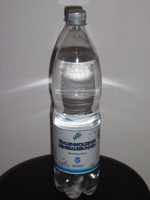Plastic bottle
A plastic bottle is a bottle constructed of plastic, with a neck that is narrower than its body and an opening at the top. The mouth of the bottle is normally sealed with a plastic bottle cap [1]. Plastic bottles are typically used to store liquids such as water, soft drinks, motor oil, cooking oil, medicine, shampoo, milk, and ink. This article provides a description of common plastic container resin materials, their qualities, usages, and limitations.
History
Leonardo Da Vinci invented the first form of natural plastic during the Renaissance period.[2] The plastic Da Vinci created was made from both animal and vegetable glues combined with organic fibers.[2] When this combination dried Da Vinci was left with a product that would be described today as a plastic-like substance.[2] In 1862, Alexander Parkes was responsible for introducing the first manmade plastic at the Great International Exhibition in London.[2] This manmade plastic was nicknamed Parkesine. Due to an extremely expensive production cost of raw materials as well as the combustability of the finished product, the product became obsolete.[2]
Plastic bottles were first used commercially in 1947,[3] but remained relatively expensive until the early 1960s when high-density polyethylene was introduced.[4] They quickly became popular with both manufacturers and customers due to their lightweight nature and relatively low production costs compared with glass bottles.[5] The food industry has almost completely replaced glass in many cases with plastic bottles, but wine and beer are still commonly sold in glass bottles.
Construction
Plastic bottles are formed using a variety of techniques. The choice of material varies depending upon application.
- High Density Polyethylene (HDPE) is the most widely used resin for plastic bottles. This material is economical, impact resistant, and provides a good moisture barrier. HDPE is compatible with a wide range of products including acids and caustics but is not compatible with solvents. It is supplied in FDA approved food grade. HDPE is naturally translucent and flexible. The addition of color will make HDPE opaque although not glossy. HDPE lends itself readily to silk screen decoration. While HDPE provides good protection at below freezing temperatures, it cannot be used with products filled at over 160 °F (71 °C) or products requiring a hermetic (vacuum) seal.
- Low Density Polyethylene (LDPE) is similar to HDPE in composition. It is less rigid and generally less chemically resistant than HDPE, but is more translucent. LDPE is used primarily for squeeze applications. LDPE is significantly more expensive than HDPE.
- Polyethylene Terephthalate (PET, PETE or polyester) is commonly used for carbonated beverage, water bottles and many food products. PET provides very good alcohol and essential oil barrier properties, generally good chemical resistance (although acetones and ketones will attack PET) and a high degree of impact resistance and tensile strength. The orienting process serves to improve gas and moisture barrier properties and impact strength. This material does not provide resistance to very high temperature applications—max. temp. 200 °F (93 °C).
- Polyvinyl Chloride (PVC) is naturally clear, has extremely good resistance to oils, and has very low oxygen transmission. It provides an excellent barrier to most gases and its drop impact resistance is also very good. This material is chemically resistant, but it is vulnerable to solvents. PVC is an excellent choice for salad oil, mineral oil, and vinegar. It is also commonly used for shampoos and cosmetic products. PVC exhibits poor resistance to high temperatures and will distort at 160 °F (71 °C), making it incompatible with hot filled products. It has attained notoriety in recent years due to potential health risks.
- Polypropylene (PP) is used primarily for jars and closures and provides a rigid package with excellent moisture barrier. One major advantage of polypropylene is its stability at high temperatures, up to 220 °F (104 °C). Polypropylene is autoclavable and offers the potential for steam sterilization. The compatibility of PP with high filling temperatures is responsible for its use with hot fill products. PP has excellent chemical resistance, but provides poor impact resistance in cold temperatures.
- Polystyrene (PS) offers excellent clarity and stiffness at an economical cost. It is commonly used with dry products including vitamins, petroleum jellies, and spices. Styrene does not provide good barrier properties, and exhibits poor impact resistance.
- Fluorine Treated (HDPE) bottles are exposed to fluorine gas in a secondary operation, are similar in appearance to HDPE and have exceptional barrier properties to hydrocarbons and aromatic solvents. Fluorine treated bottles are excellent for use with insecticides, pesticides, herbicides, photographic chemicals, agricultural chemicals, household and industrial cleaners, electronic chemicals, medical cleaners and solvents, citrus products, d-limone, flavors, fragrances, essential oils, surfactants, polishes, additives, graffiti cleaning products, pre-emergents, stone and tile care products, waxes, paint thinner, gasoline, biodiesel, xylene, acetone, kerosene and more.
- For non-bottle applications, fluorination of plastic can provide compliance with state and federal regulations. An example would be fluorination plastic fuel tanks used for lawn and garden equipment, automobiles, etc.
- Post Consumer Resin (PCR) is a blend of reclaimed natural HDPE (primarily from milk and water containers) and virgin resin. The recycled material is cleaned, ground and recompounded into uniform pellets along with prime virgin material especially designed to build up environmental stress crack resistance. PCR has no odor but exhibits a slight yellow tint in its natural state. This tint can be hidden by the addition of color. PCR is easily processed and inexpensive. However, it cannot come into direct contact with food or pharmaceutical products. PCR can be produced in a variety of recycled content percentages up to 100%.
- K-Resin (SBC) is ideally suited to a wide variety of packaging applications by virtue of its sparkling clarity, high gloss, and impact resistance. K-Resin, a styrene derivative, is easily processed on polyethylene equipment. It is suitable for packaging many products but is specifically incompatible with fats and unsaturated oils or solvents. This material is frequently used for display and point-of-purchase packaging.
- Bioplastic - polymer structures based on processed biological materials rather than petrochemicals.
Labeling
Plastic bottles are marked at their base with the Resin identification code to indicate the material used:
- 1 - PET (Polyethylene Terephthalate)
- 2 - HDPE (High Density Polyethylene)
- 3 - PVC (Polyvinyl Chloride)
- 4 - LDPE (Low Density Polyethylene)
- 5 - PP (Polypropylene)
- 6 - PS (Polystyrene)
- 7 - Other
See also
References
- Jump up ↑ "Bottle". Retrieved 2008-04-23.
- ↑ Jump up to: 2.0 2.1 2.2 2.3 2.4 "History of Plastic". Retrieved 2008-10-01.
- Jump up ↑ "The Plastic Bottle". Retrieved 2008-04-23.
- Jump up ↑ "The History of soft drink Timeline". Retrieved 2008-04-23.
- Jump up ↑ "The history of plastic". Retrieved 2008-04-23.
External links

